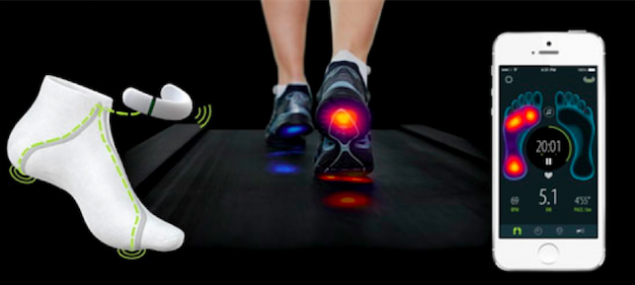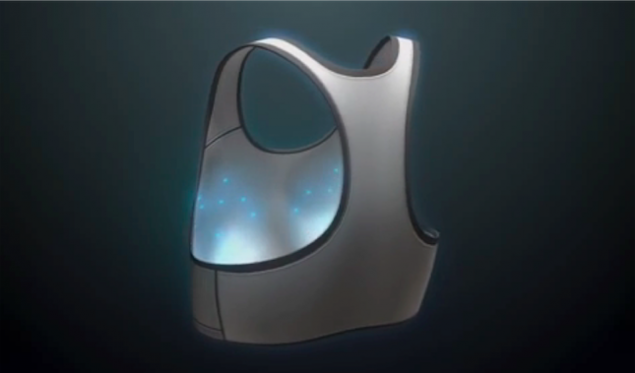1512
Why do you still wear stupid clothes?
Intel CEO Brian Krzanich put on a show at the Code Conference in California in May. While on stage, he suddenly unbuttoned his shirt. Underneath it was something like a bicycle jersey. Krzanich showed the screen of his smartphone, and the audience saw his heartbeat speed up.

Imagine your clothes telling you when and what doctor you should see. Or the app in the smartphone is customized depending on your mood. “Smart clothing” offers amazing opportunities.
At MadRobots, of course, we are following this trend with interest. Here you can find the sensational pillow Ostrich Pillow. And today we decided to collect in one post the most interesting novelties of high-tech clothing, some of which in the future can even save your life. If you have seen other interesting “smart things”, share the findings in the comments.
A shirt that knows everything about your health
Intel is developing wearable technology based on its new Edison miniature computer in partnership with AiQ Smart Clothing. This Taiwanese company has been experimenting with weaving stainless steel into yarn since 2009.
Over the past five years, AiQ has produced several high-tech textile products. BioMan shirt (Brian Krzanich showed something similar), perhaps the most interesting achievement of the company. It connects to your phone via Bluetooth, continuously monitoring your breathing, heartbeat and body temperature. It is important that in this shirt you can sweat, crumple it, and then throw in the washing machine. She'll keep working.
If you rarely exercise, you can limit yourself. Winter gloves from AIQ to work with touch screens (although this is difficult to surprise). There are heated clothes. LED jackets. And – for the most cautious – clothes that protect against electromagnetic and radioactive radiation.
Many will say that the appearance of AIQ clothing leaves much to be desired. Yes, while smart clothes are far from high fashion. But it eliminates the need to hang the wrists and other parts of the body additional gadgets.
You can take a look at other manufacturers. For example, Hexoskin, with offices in Canada and the U.S., supplies similar clothing with built-in sensors to professional athletes and even astronauts. You can buy it in a regular online store.
In the summer of 2014, Omsignal will start selling biometric clothing (https://smartclothinglab.com/brands/what-happened-to-omsignal/).
USB jacket
Clothing experiments are conducted by companies with a name. The famous manufacturer of tourist clothing Columbia uses the technology Omni-Heat Electric in their jackets, gloves and shoes.
The jacket has two batteries that take up space near the chest. "Heaters" are made in the form of a thin flexible wire, so that the appearance does not spoil and do not interfere with wearing. A USB cable jacket is charged. And this is a nice bonus for travelers, the jacket can share the charge with other devices through the same USB. Columbia says the charge lasts six hours. Prices for these jackets in Russia vary from 6 to 30 thousand rubles.
However, judging by the reviews, the clothes are a little heavy, recharge not as quickly as you would like, and with severe frosts, even with the included heating of light shivering from the cold, you can not avoid (review authors mention minus 23 degrees Celsius, although Columbia assures that the clothes will help with minus 32). Another drawback is not the most successful location of the sensor for the inclusion and regulation of heating power. Columbia placed it on his chest, and with a tied scarf or in sports gear to feel a small sensor is not so easy.
Bed linen for reading biometrics
A major Japanese telecom operator NTT Docomo together with Toray are also preparing to release a line of “smart clothing” under the Hitoe brand. The company plans to produce not only clothes, but also Bedding that reads biometrics during sleep.
Suit for monitoring 22 muscle groups
If it is important to observe the individual muscles of your body, then pay attention to Athos clothing. The company was founded by two graduates of the Canadian University of Waterloo. In addition to tracking the breath and heartbeat, this Exercise suit tracks all 22 muscle groups, and transfers all data to the smartphone application.
Smart shoe insoles
At all manufacturers, the average price of a set of shirts, data transfer module and charging is about $200-400. For delivery, of course, will have to pay extra. For a smaller budget, about $100, in the second half of 2014 you will be able to buy insoles FootLoggers.
Insert them in your usual shoes, do your own thing (the battery lasts for 24 hours), then take them out and put them on ShoeStation. This docking device charges the insoles and takes the accumulated data via Bluetooth. After analysis, the data comes to you in a smartphone application or by SMS.
It is assumed that these insoles can be used not only for sports, but also for the diagnosis of diseases associated with gait disturbance.
Socks that save from injuries and complications of diabetes
American manufacturer of “smart clothing” for sports Heapsylon purposefully expands the use of its products and medicine. Sensoria socks This company calculates your steps, calories expended, distance traveled. They track your technique and notice injuries. The algorithm is being refined, and soon socks may even warn you that you may fall.

Doctors with the help of these socks identify complications of diabetes in patients. The sensor continuously transmits data to the mobile device, and doctors can notice and prevent diabetic foot ulcers in a timely manner. Similar tests are already underway.
Bra diagnosing breast disease
Heapsylon is preparing to begin testing a bra in the second half of 2014 that warns women about the possibility of breast cancer using thermodynamic sensors and circadian rhythm analysis. Recent studies have linked these parameters to changes in the metabolism of breast cells.

Pajamas saving in a dream
For sufferers of night apnea syndrome Heapsylon plans to release pajamas. She'll notice the breathing problem in time. It'll give you an alarm. Experts see the next step in the development of technology in analyzing the chemical composition of your body. Clothing will take blood, sweat, tears and even urine tests.
Wi-Fi transmitter made from fabric
Every year, specialists around the world create new fabrics with amazing technical properties. For example, Catholic University of Leuven and Perlis University of Malaysia In early 2014, they announced that they had made a dual-frequency (2.45 and 5.4 GHz) Wi-Fi transmitter entirely from fabric using metamaterials. The shielding layer minimizes interference from the human body.

Costume gadget for listening to music and distributing the Internet
Dutch designer Borr Ackersdijk He has long experimented with creating fabric on a 3D printer. And at the March festival, SXSW attracted attention with its BB.Suit suit made of a mixture of cotton and synthetic fibers, as well as copper thread. As a result, a wearable gadget with built-in GPS, Wi-Fi, NFC and Bluetooth directly into the fabric was obtained.
So far, there are only two copies of BB.Suit, which will probably remain a prototype. However, Ackersdijk plans to develop the technology and engage in mass production of “smart clothes”.
A T-shirt that doesn't get dirty
A young entrepreneur named Amir PatelT-shirts from which sweat, water, sauces and other liquids roll, leaving no trace. This effect helps to achieve hydrophobic technologies. Fluid molecules bounce off the fabric thanks to microscopic silica particles that create an air barrier near the surface of clothing. To launch production under the Silic brand, Patel turned to Kickstarter participants and did not regret it. Wanted to raise $ 20 thousand, in the end received about $ 300 thousand. The good news for bachelors: such T-shirts can be worn without washing much longer than usual, because for the reproduction of bacteria you need moisture, and Patel’s products do not accumulate it. It is still possible to wash such fabric. “Protective” properties persist even after 80 washes.
A jacket that warms when needed
The fabric is also being experimented with at the University of Texas Dallas. Scientists have interwoven a polyethylene fishing line and a nylon thread into a fiber that can withstand a weight of 1 ton and produce torque comparable in power to a jet engine. And the fiber is compressed and decompressed depending on the temperature. The researchers plan to incorporate a new fiber into their clothes.In cold weather, your jacket kept warm, and in the heat, on the contrary, cooled..
While the main “smart clothes” is often ridiculous in appearance, not too convenient and, of course, too expensive. But perhaps a few years from now, we will look back and wonder how it was possible to wear the stupid clothes we wear today.
By the way, a smart washing machine is already at your service.
Source: habrahabr.ru/company/madrobots/blog/227485/

Imagine your clothes telling you when and what doctor you should see. Or the app in the smartphone is customized depending on your mood. “Smart clothing” offers amazing opportunities.
At MadRobots, of course, we are following this trend with interest. Here you can find the sensational pillow Ostrich Pillow. And today we decided to collect in one post the most interesting novelties of high-tech clothing, some of which in the future can even save your life. If you have seen other interesting “smart things”, share the findings in the comments.
A shirt that knows everything about your health
Intel is developing wearable technology based on its new Edison miniature computer in partnership with AiQ Smart Clothing. This Taiwanese company has been experimenting with weaving stainless steel into yarn since 2009.
Over the past five years, AiQ has produced several high-tech textile products. BioMan shirt (Brian Krzanich showed something similar), perhaps the most interesting achievement of the company. It connects to your phone via Bluetooth, continuously monitoring your breathing, heartbeat and body temperature. It is important that in this shirt you can sweat, crumple it, and then throw in the washing machine. She'll keep working.
If you rarely exercise, you can limit yourself. Winter gloves from AIQ to work with touch screens (although this is difficult to surprise). There are heated clothes. LED jackets. And – for the most cautious – clothes that protect against electromagnetic and radioactive radiation.
Many will say that the appearance of AIQ clothing leaves much to be desired. Yes, while smart clothes are far from high fashion. But it eliminates the need to hang the wrists and other parts of the body additional gadgets.
You can take a look at other manufacturers. For example, Hexoskin, with offices in Canada and the U.S., supplies similar clothing with built-in sensors to professional athletes and even astronauts. You can buy it in a regular online store.
In the summer of 2014, Omsignal will start selling biometric clothing (https://smartclothinglab.com/brands/what-happened-to-omsignal/).
USB jacket
Clothing experiments are conducted by companies with a name. The famous manufacturer of tourist clothing Columbia uses the technology Omni-Heat Electric in their jackets, gloves and shoes.
The jacket has two batteries that take up space near the chest. "Heaters" are made in the form of a thin flexible wire, so that the appearance does not spoil and do not interfere with wearing. A USB cable jacket is charged. And this is a nice bonus for travelers, the jacket can share the charge with other devices through the same USB. Columbia says the charge lasts six hours. Prices for these jackets in Russia vary from 6 to 30 thousand rubles.
However, judging by the reviews, the clothes are a little heavy, recharge not as quickly as you would like, and with severe frosts, even with the included heating of light shivering from the cold, you can not avoid (review authors mention minus 23 degrees Celsius, although Columbia assures that the clothes will help with minus 32). Another drawback is not the most successful location of the sensor for the inclusion and regulation of heating power. Columbia placed it on his chest, and with a tied scarf or in sports gear to feel a small sensor is not so easy.
Bed linen for reading biometrics
A major Japanese telecom operator NTT Docomo together with Toray are also preparing to release a line of “smart clothing” under the Hitoe brand. The company plans to produce not only clothes, but also Bedding that reads biometrics during sleep.
Suit for monitoring 22 muscle groups
If it is important to observe the individual muscles of your body, then pay attention to Athos clothing. The company was founded by two graduates of the Canadian University of Waterloo. In addition to tracking the breath and heartbeat, this Exercise suit tracks all 22 muscle groups, and transfers all data to the smartphone application.
Smart shoe insoles
At all manufacturers, the average price of a set of shirts, data transfer module and charging is about $200-400. For delivery, of course, will have to pay extra. For a smaller budget, about $100, in the second half of 2014 you will be able to buy insoles FootLoggers.
Insert them in your usual shoes, do your own thing (the battery lasts for 24 hours), then take them out and put them on ShoeStation. This docking device charges the insoles and takes the accumulated data via Bluetooth. After analysis, the data comes to you in a smartphone application or by SMS.
It is assumed that these insoles can be used not only for sports, but also for the diagnosis of diseases associated with gait disturbance.
Socks that save from injuries and complications of diabetes
American manufacturer of “smart clothing” for sports Heapsylon purposefully expands the use of its products and medicine. Sensoria socks This company calculates your steps, calories expended, distance traveled. They track your technique and notice injuries. The algorithm is being refined, and soon socks may even warn you that you may fall.

Doctors with the help of these socks identify complications of diabetes in patients. The sensor continuously transmits data to the mobile device, and doctors can notice and prevent diabetic foot ulcers in a timely manner. Similar tests are already underway.
Bra diagnosing breast disease
Heapsylon is preparing to begin testing a bra in the second half of 2014 that warns women about the possibility of breast cancer using thermodynamic sensors and circadian rhythm analysis. Recent studies have linked these parameters to changes in the metabolism of breast cells.

Pajamas saving in a dream
For sufferers of night apnea syndrome Heapsylon plans to release pajamas. She'll notice the breathing problem in time. It'll give you an alarm. Experts see the next step in the development of technology in analyzing the chemical composition of your body. Clothing will take blood, sweat, tears and even urine tests.
Wi-Fi transmitter made from fabric
Every year, specialists around the world create new fabrics with amazing technical properties. For example, Catholic University of Leuven and Perlis University of Malaysia In early 2014, they announced that they had made a dual-frequency (2.45 and 5.4 GHz) Wi-Fi transmitter entirely from fabric using metamaterials. The shielding layer minimizes interference from the human body.

Costume gadget for listening to music and distributing the Internet
Dutch designer Borr Ackersdijk He has long experimented with creating fabric on a 3D printer. And at the March festival, SXSW attracted attention with its BB.Suit suit made of a mixture of cotton and synthetic fibers, as well as copper thread. As a result, a wearable gadget with built-in GPS, Wi-Fi, NFC and Bluetooth directly into the fabric was obtained.
So far, there are only two copies of BB.Suit, which will probably remain a prototype. However, Ackersdijk plans to develop the technology and engage in mass production of “smart clothes”.
A T-shirt that doesn't get dirty
A young entrepreneur named Amir PatelT-shirts from which sweat, water, sauces and other liquids roll, leaving no trace. This effect helps to achieve hydrophobic technologies. Fluid molecules bounce off the fabric thanks to microscopic silica particles that create an air barrier near the surface of clothing. To launch production under the Silic brand, Patel turned to Kickstarter participants and did not regret it. Wanted to raise $ 20 thousand, in the end received about $ 300 thousand. The good news for bachelors: such T-shirts can be worn without washing much longer than usual, because for the reproduction of bacteria you need moisture, and Patel’s products do not accumulate it. It is still possible to wash such fabric. “Protective” properties persist even after 80 washes.
A jacket that warms when needed
The fabric is also being experimented with at the University of Texas Dallas. Scientists have interwoven a polyethylene fishing line and a nylon thread into a fiber that can withstand a weight of 1 ton and produce torque comparable in power to a jet engine. And the fiber is compressed and decompressed depending on the temperature. The researchers plan to incorporate a new fiber into their clothes.In cold weather, your jacket kept warm, and in the heat, on the contrary, cooled..
While the main “smart clothes” is often ridiculous in appearance, not too convenient and, of course, too expensive. But perhaps a few years from now, we will look back and wonder how it was possible to wear the stupid clothes we wear today.
By the way, a smart washing machine is already at your service.
Source: habrahabr.ru/company/madrobots/blog/227485/
Lake shopping center on the site
Activité: fitness tracker that does not look like all the other trackers























